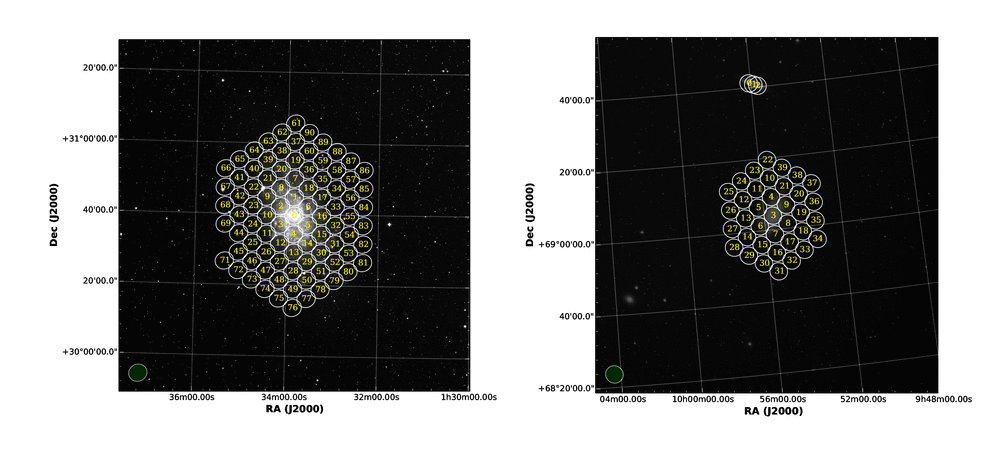Daily Image
09-12-2016The LOFAR search for radio pulsars and fast transients in nearby galaxies M33, M81 & M82
| Submitter: | Klim Mikhailov and Joeri van Leeuwen |
| Description: | The diverse populations of radio pulsars and rotating radio transients are only known in and close to the Milky Way. To investigate whether other galaxies host similar populations, deep pulsar and transient searches are required. For pulsars in other galaxies, the discovery would set a guide for the source birth rate, population synthesis (as a result of star-formation rate and mass-energy distribution), the spatial and flux density distributions. The subsequent timing would probe scintillation and scattering tails, profile variations, interstellar medium (ISM) in host galaxies as well as intergalactic medium (IGM), an important quantity to distinguish Fast Radio Bursts (FRBs). Several attempts have been made in the past to capture periodic and single pulse signals from nearby galaxies, with different telescopes: Arecibo, Parkes, GBT, and WSRT (covered frequency range: 328-1440 MHz). None of them, however, discovered new sources. Only among relatively close stellar overdensities - globular clusters and nearest neighbour galaxies of the Local Galactic Group, the Small and Large Magellanic Clouds - pulsar discoveries have been made. With LOFAR HBA antennas, it is possible to track several nearby galaxies at the wavelengths where the pulsar flux density distribution peaks. The large bandwidth, high core gain, and multi-beaming functionality allow for efficient, deep integrations. We performed 4-h radio observations of nearby galaxies M33, M81 and M82 with LOFAR. We coherently combined at most 23 LOFAR HBA stations to completely cover M33, and both M81 and M82. The search did not result in any new pulsars or transients from M33, M81 or M82. To compare against our knowledge from the Milky Way, we virtually put all Galactic pulsars at the distances to M81/M82 and M33. Figure 2 shows the expected flux density versus pulse period, for those assumed populations. The LOFAR sensitivity curves are drawn for several DMs, however only the most realistic (highest) DM for M33/M81/M82 shows the error contour. The most luminous Galactic pulsar, PSR J1305-6455, is denoted with a star. Panel (a) shows that our survey was sensitive enough to detect almost the entire, actual Galactic pulsar population. Panel (b) demonstrates our sensitivity if these same pulsars are put at the distance to M82/M81 (left y-axis) and M33 (right y-axis). Our conclusion is that, compared to the Milky Way population, there are no extragalactic pulsars shining toward Earth that are brighter by only a factor of a few in M33, and by an order of magnitude in M81 or M82. The results are presented in A&A (in print: [1]) by Klim Mikhailov and Joeri van Leeuwen, and can also be found here: https://arxiv.org/abs/1605.04165 References: [1] http://www.aanda.org/articles/aa/abs/2016/09/aa28348-16/aa28348-16.html |
| Copyright: | Beams and sensitivity plots: K. Mikhailov. Background images of nearby galaxies: CDS Portal |
| Tweet |  |
